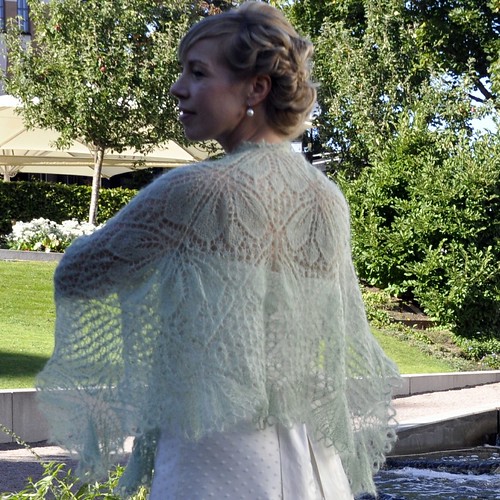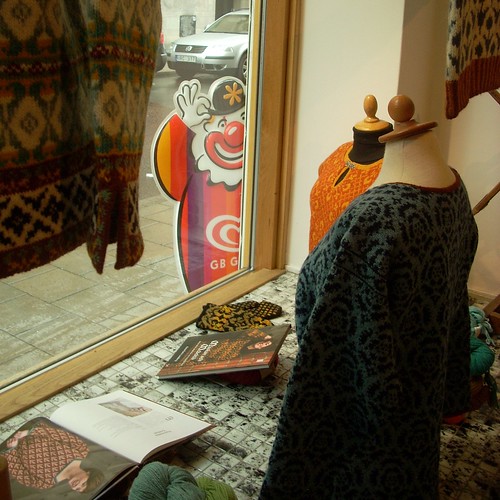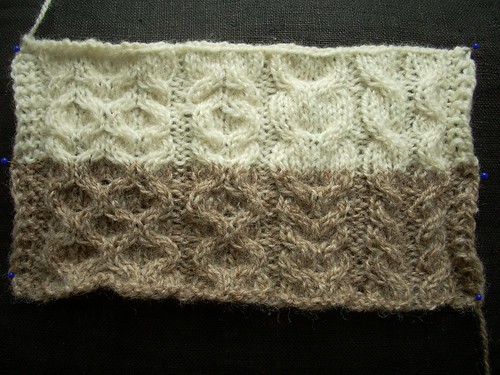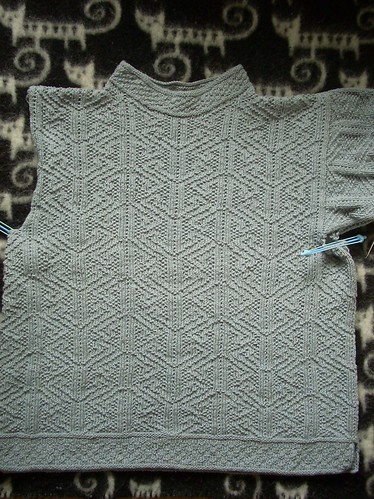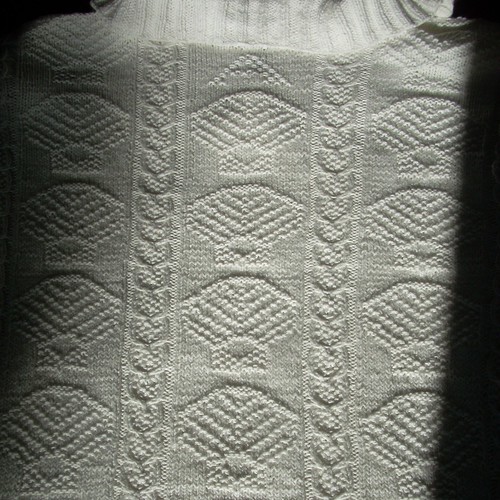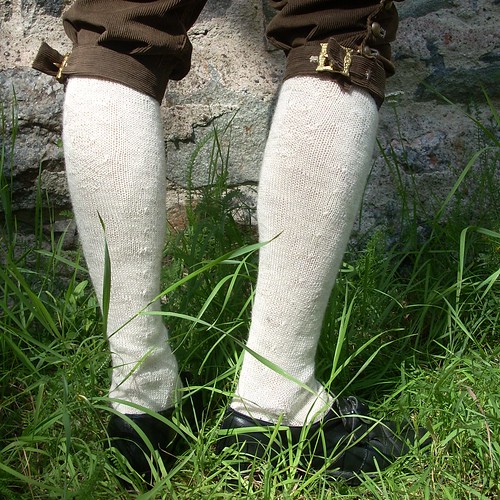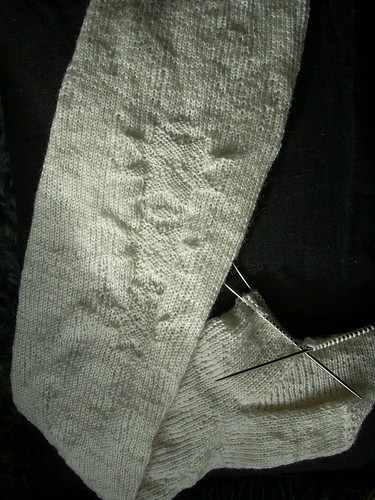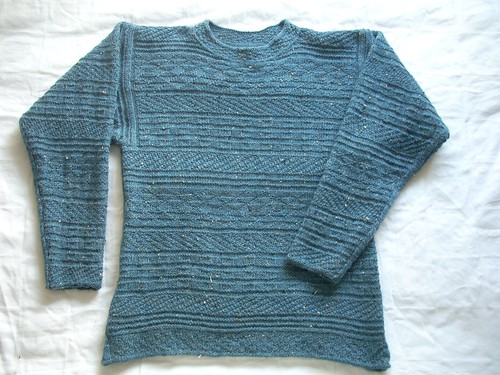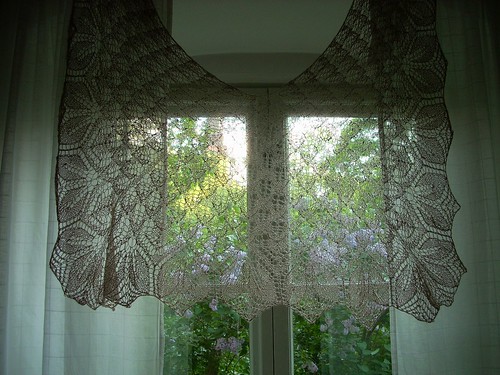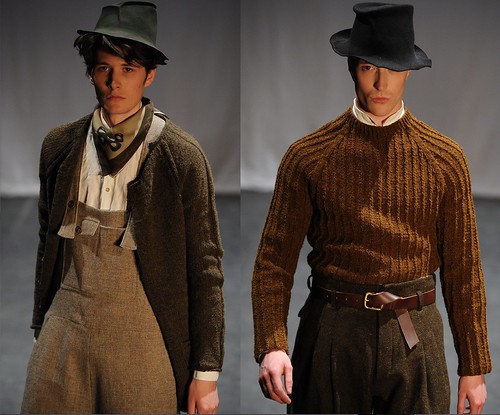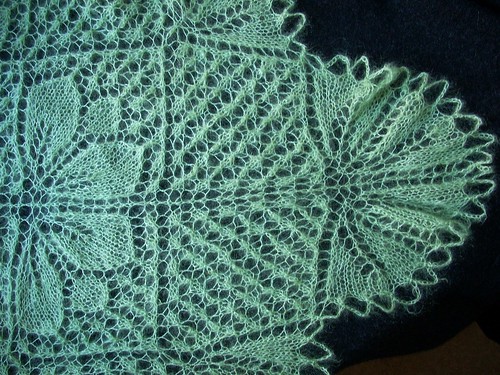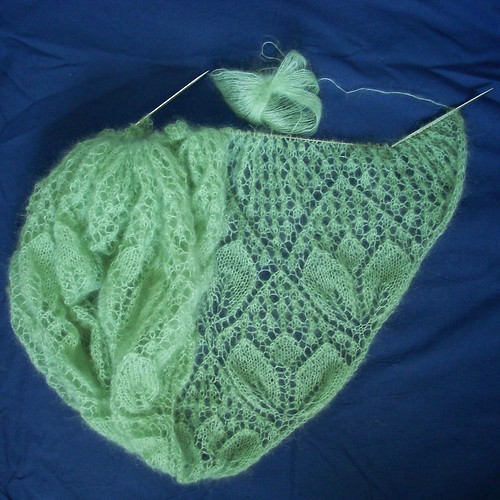Once a month there's a knittig café at
Nordiska museet in Stockholm. (Not just a café, you can - and occasionally do - get a glass of wine too.) I was there yesterday and had a great time with knitter friends like
Maria and
Born to knit.
However, one of the first people I saw when I entered the museum was Queen Silvia, which was quite a surprise! She hadn't brought any knitting as far as I could see (shockingly bad manners) but was inspecting an upcoming exhibition of antiquities. Perhaps I should have invited her to join us?
I have almost finished my "Roman Crystal" shawl. The pattern is Marianne Kinzel's "English Crystal" from her
First Book of Modern Lace Knitting. Thanks Ron for opening my eyes to the beauty of it! I made another shawl using this pattern not too long ago, but it's such a fun pattern to knit I wanted to use it again to bring out the beauty of the cashmere I bought in Rome recently.
The original design is a square that consists of four triangles and that is knitted in the round; instead, I knit three triangles back and forth. I also changed the edge. In the previous shawl (see photo above) I simply took the "Peacock's Eye" from another design in the same book. Sometimes I feel like Dr Frankenstein.
I tried the same idea now, but the cashmere is so much thicker that the big holes looked rather clumsy. Therefore, I kept the shape of the edge, but made three smaller holes instead.
 |
| "Roman Crystal" shawl in progress |
Now that the shawl is almost finished I wish I had bought more of the yarn, but at the same time I'm happy I made up my mind how to use it so quickly as it is such a treat to work with.
There were a number of reasons behind my choice - here are the main ones that I always have in mind:
1. How to bring out the beauty of the yarn. In this case I thought the stocking-stitch parts would show off the lovely, slightly heathery shade of red.
2. What kind of garment is the yarn quality suitable for? Light and soft would make a nice shawl.
3. What is there enough yarn for? As I haven't worked with this yarn before, I couldn't be sure. (That's one of the main reasons I often use the same yarns over and over again.) A shawl with this kind of pattern is a good choice as you add repeats until you're out of yarn. (Well, not quite as simple as that in reality, but almost.)
4. Will I enjoy knitting it? As I probably have written before, I think life is too short to knit things I don't enjoy making. This pattern was fun to knit with enough variation to keep it from gettting monotonous - and it's quite fascinating seeing how different a pattern turns out depending on the yarn you choose.
5. Do I like the way it looks? Even if I won't wear it myself I want to enjoy looking at it while making it.
Regarding the last two points, I could add that I'm a proud member of the "Selfish knitters" group on Ravelry! I'm less selfish when it comes to making presents of the things I make - at least I hope and think so, even though I'm well aware I have far more sweaters than I need. ;-)
Kashmirsjalen är nästan klar - nu önskar jag att jag hade köpt mer! Det får bli fler resor till Rom, helt enkelt. Mönstret är "English Crystal" av Marianne Kinzel, men jag har gjort några ändringar. Originalet är en fyrkantig duk som består av fyra trianglar och som är stickad runt; jag har stickat tre trianglar fram och tillbaka i stället.
Jag har också gjort om kanten genom att knycka "Peacock's Eye" från samma bok ("First Book of Modern Lace Knitting") fast jag gjorde om den också genom att byta ut ett enda stort hål mot tre mindre, detta för att jag tyckte att det såg lite klumpigt ut med det här garnet som är tjockare än vad jag brukar välja till sjalar. Däremot stickade jag det enligt mönstret i en sjal jag gjorde tidigare i år - hur det blev kan man se i bilden överst i det här inlägget.
Det är inte så ofta jag stickar nästan samma mönster två gånger så tätt inpå varandra, men det här är ett roligt mönster med lagom mycket variation. Dessutom tänkte jag att det skulle passa till garnet. Allmänt kan jag säga att det finns fem faktorer som alltid ligger bakom mina val av projekt:
1. Hur får man garnet att komma till sin rätt? I det här fallet tänkte jag att de slätstickade partierna skulle framhäva de vackra skiftningarna i det röda.
2. Vad passar garnet till för slags plagg? Det här garnet var så mjukt och lätt att jag tänkte att det skulle kunna bli en skön sjal.
3. Hur mycket räcker garnet till? Ofta använder jag samma garner gång på gång, dels för att jag tycker att de håller hög kvalitet, dels för att jag vet på ett ungefär hur mycket som går åt till en tröja eller sjal. Det här garnet var en ny bekant, så en sjal kändes ganska säkert - man kan sticka så länge garnet räcker. (Riktigt så enkelt är det ju inte i verkligheten, men nästan.)
4. Kommer det att vara roligt att sticka? Livet är för kort för att sticka saker som jag inte gillar att sticka - och det ingår alltid moment som är rätt trista i alla fall. Det här mönstret var som sagt roligt och det är riktigt fascinerande att se hur olika samma mönster kan ta sig ut med olika garnkvaliteter. Oftast vill jag testa någon ny idé, så att jag känner att jag lär mig nya saker.
5. Tycker jag om hur det ser ut? Även om jag inte kommer att bära plagget själv så vill jag tycka om att titta på det under arbetets gång.
Jag är alltså ganska väldigt kräsen och rätt självisk när det gäller mina projekt. Mindre självisk när det gäller resultatet i alla fall. En hel del ger jag bort - fast visst är det så att jag har betydligt fler tröjor än jag egentligen behöver... ("Egentligen" är ett bra ord!)



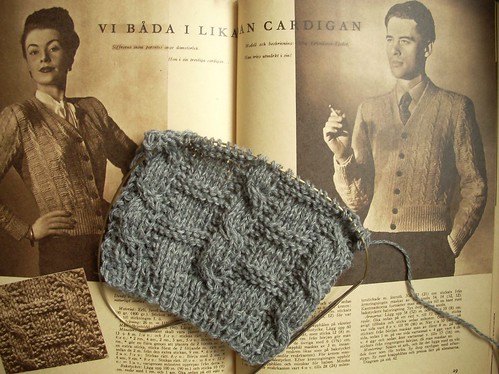



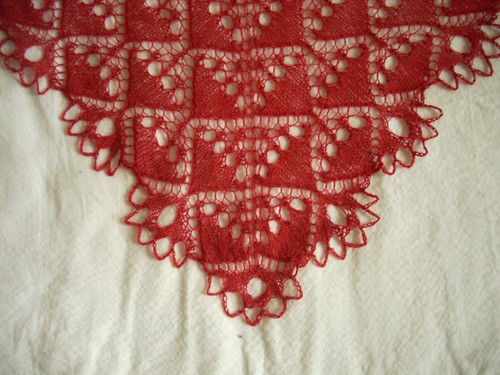

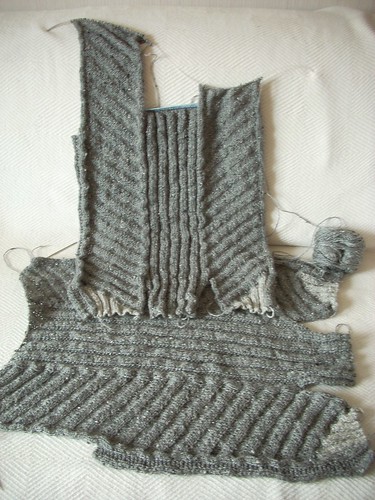


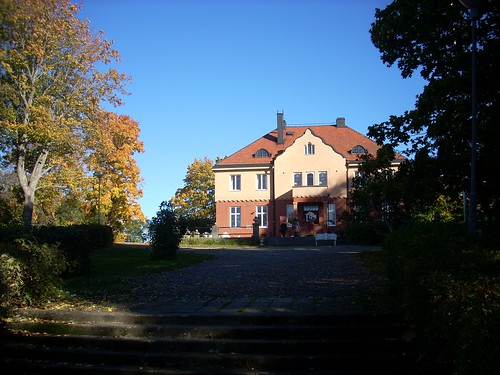




.jpg)
